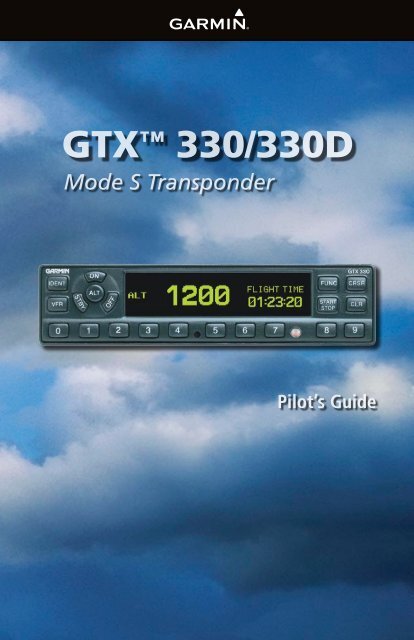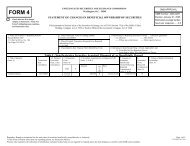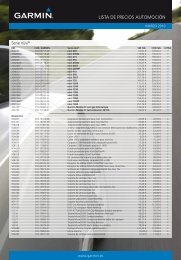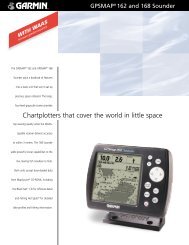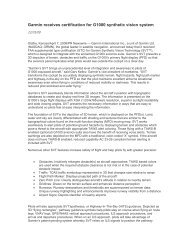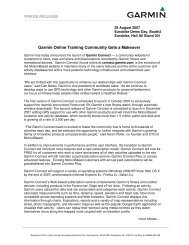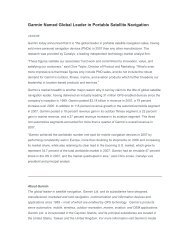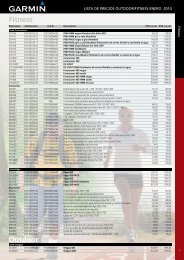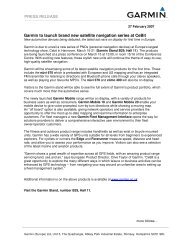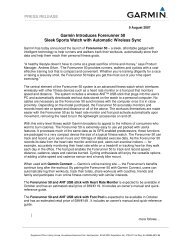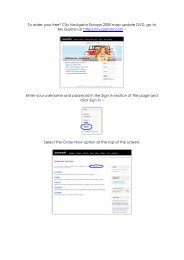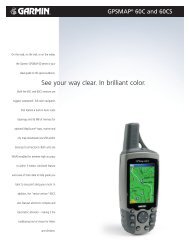GTX™ 330/330D - Garmin
GTX™ 330/330D - Garmin
GTX™ 330/330D - Garmin
Create successful ePaper yourself
Turn your PDF publications into a flip-book with our unique Google optimized e-Paper software.
GTX <strong>330</strong>/<strong>330</strong>D<br />
Mode S Transponder<br />
Pilot’s Guide
© Copyright 2002, 2007, 2008<br />
<strong>Garmin</strong> Ltd. or its subsidiaries<br />
All Rights Reserved<br />
Except as expressly provided herein, no part of this manual may be reproduced, copied,<br />
transmitted, disseminated, downloaded or stored in any storage medium, for any purpose<br />
without the express prior written consent of <strong>Garmin</strong>. <strong>Garmin</strong> hereby grants permission to<br />
download a single copy of this manual and of any revision to this manual onto a hard drive or<br />
other electronic storage medium to be viewed and to print one copy of this manual or of any<br />
revision hereto, provided that such electronic or printed copy of this manual or revision must<br />
contain the complete text of this copyright notice and provided further that any unauthorized<br />
commercial distribution of this manual or any revision hereto is strictly prohibited.<br />
This manual is written for software version 6.00 or later, and is not suitable for earlier software<br />
versions. Some differences in operation may be observed when comparing the information in<br />
this manual to earlier or later software versions.<br />
Software License Agreement<br />
BY USING THE GTX <strong>330</strong>, YOU AGREE TO BE BOUND BY THE TERMS AND CONDITIONS<br />
OF THE FOLLOWING SOFTWARE LICENSE AGREEMENT. PLEASE READ THIS<br />
AGREEMENT CAREFULLY.<br />
<strong>Garmin</strong> grants you a limited license to use the software embedded in this device (the<br />
“Software”) in binary executable form in the normal operation of the product. Title, ownership<br />
rights and intellectual property rights in and to the Software remain in <strong>Garmin</strong>.<br />
You acknowledge that the Software is the property of <strong>Garmin</strong> and is protected under the<br />
United States of America copyright laws and international copyright treaties. You further<br />
acknowledge that the structure, organization and code of the Software are valuable trade<br />
secrets of <strong>Garmin</strong> and that the Software in source code form remains a valuable trade secret of<br />
<strong>Garmin</strong>. You agree not to decompile, disassemble, modify, reverse assemble, reverse engineer<br />
or reduce to human readable form the Software or any part thereof or create any derivative<br />
works based on the Software. You agree not to export or re-export the Software to any country<br />
in violation of the export control laws of the United States of America.<br />
CAUTION: The GTX <strong>330</strong> should be turned off before starting or shutting<br />
down aircraft engine(s).<br />
NOTE: Reference to the GTX <strong>330</strong> Transponder throughout this Pilot’s Guide<br />
includes operation of the GTX <strong>330</strong>D Diversity Transponder also.<br />
NOTE: Contact a <strong>Garmin</strong> authorized dealer for software updates.<br />
September 2008 Part Number 190-00207-00 Rev. F Printed in USA
Limited Warranty<br />
This <strong>Garmin</strong> product is warranted to be free from defects in materials or workmanship for<br />
two years from the date of purchase. Within this period, <strong>Garmin</strong> will at its sole option, repair<br />
or replace any components that fail in normal use. Such repairs or replacement will be made<br />
at no charge to the customer for parts or labor, provided that the customer shall be responsible<br />
for any transportation cost. This warranty does not cover failures due to abuse, misuse,<br />
accident or unauthorized alteration or repairs.<br />
THE WARRANTIES AND REMEDIES CONTAINED HEREIN ARE EXCLUSIVE AND IN<br />
LIEU OF ALL OTHER WARRANTIES EXPRESS OR IMPLIED OR STATUTORY, INCLUDING<br />
ANY LIABILITY ARISING UNDER ANY WARRANTY OF MERCHANTABILITY OR FITNESS<br />
FOR A PARTICULAR PURPOSE, STATUTORY OR OTHERWISE. THIS WARRANTY GIVES<br />
YOU SPECIFIC LEGAL RIGHTS, WHICH MAY VARY FROM STATE TO STATE.<br />
IN NO EVENT SHALL GARMIN BE LIABLE FOR ANY INCIDENTAL, SPECIAL,<br />
INDIRECT OR CONSEQUENTIAL DAMAGES, WHETHER RESULTING FROM THE USE,<br />
MISUSE, OR INABILITY TO USE THIS PRODUCT OR FROM DEFECTS IN THE PRODUCT.<br />
Some states do not allow the exclusion of incidental or consequential damages, so the above<br />
limitations may not apply to you.<br />
<strong>Garmin</strong> retains the exclusive right to repair or replace the unit or software or offer a full<br />
refund of the purchase price at its sole discretion. SUCH REMEDY SHALL BE YOUR SOLE<br />
AND EXCLUSIVE REMEDY FOR ANY BREACH OF WARRANTY.<br />
To obtain warranty service, contact your local <strong>Garmin</strong> Authorized Service Center. For<br />
assistance in locating a Service Center near you, call <strong>Garmin</strong> Customer Service at one of the<br />
numbers shown below.<br />
<strong>Garmin</strong> International, Inc. <strong>Garmin</strong> (Europe) Ltd.<br />
1200 East 151st Street Liberty House, Bulls Copse Road<br />
Olathe, Kansas 66062, U.S.A. Hounsdown Business Park<br />
Phone: 913/397.8200 Southampton, SO40 9RB, U.K.<br />
FAX: 913/397.8282 Phone: 44/0870.8501241<br />
FAX: 44/0870.8501251<br />
NOTE: It is the responsibility of the GTX <strong>330</strong> owner to obtain proper<br />
licensing before using the transponder.<br />
NOTE: The coverage expected from the GTX <strong>330</strong> is limited to line of sight.<br />
Low altitude or aircraft antenna shielding by the aircraft itself may result<br />
in reduced range. Range can be improved by climbing to a higher altitude.<br />
It may be possible to minimize antenna shielding by locating the antenna<br />
where dead spots are only noticed during abnormal flight attitudes.
The GTX <strong>330</strong> transponder is powered on by pressing the STBY, ALT or ON keys, or by a remote avionics master<br />
switch (if applicable). After power on, a start-up page is displayed while the unit performs a self test.<br />
Mode Selection Keys<br />
OFF ⎯ Powers off the GTX <strong>330</strong>. Pressing STBY, ON, or<br />
ALT key powers on the transponder displaying the last<br />
active identification code.<br />
STBY ⎯ Selects the standby mode. When in standby mode,<br />
the transponder will not reply to any interrogations.<br />
ON ⎯ Selects Mode A. In this mode, the transponder replies to<br />
interrogations, as indicated by the Reply Symbol ( ). Replies do not include altitude<br />
information.<br />
ALT ⎯ Selects Mode A and Mode C. In ALT mode, the transponder replies to<br />
identification and altitude interrogations as indicated by the Reply Symbol ( ). Replies<br />
to altitude interrogations include the standard pressure altitude received from an external<br />
altitude source, which is not adjusted for barometric pressure. The ALT mode may be<br />
selected in aircraft not equipped with an optional altitude encoder; however, the reply<br />
signal will not include altitude information.<br />
Any time the function ON or ALT is selected the transponder becomes an active part of<br />
the Air Traffic Control Radar Beacon System (ATCRBS). The transponder also responds to<br />
interrogations from TCAS equipped aircraft.<br />
Code Selection<br />
Code selection is done with eight keys (0 – 7) providing 4,096 active identification codes.<br />
Pushing one of these keys begins the code selection sequence. Digits that are not yet entered<br />
appear as dashes. The new code is activated when the fourth digit is entered. Pressing the CLR<br />
key moves the cursor back to the previous digit. Pressing the CLR key when the cursor is on<br />
the first digit of the code, or pressing the CRSR key during code entry, removes the cursor and<br />
cancels data entry, restoring the previous code. You may press the CLR key up to five seconds<br />
after code entry is complete to return the cursor to the fourth digit. The numbers 8 and 9 are not<br />
used for code entry, only for entering a Count Down time, and for adjusting contrast and display<br />
brightness.
Keys for Other GTX <strong>330</strong> Functions<br />
IDENT⎯ Pressing the IDENT key activates the Special Position<br />
Identification (SPI) Pulse for 18 seconds, identifying your transponder<br />
return from others on the air traffic controller’s screen. The word IDENT<br />
will appear in the upper left corner of the display during this time.<br />
VFR⎯ Sets the transponder code to the pre-programmed VFR code selected<br />
during installation configuration (this is set to 1200 at the factory). Pressing<br />
the VFR key again restores the previous identification code. If the VFR Key<br />
is pressed when disabled (dependent upon installation configuration) a VFR<br />
Key Disabled message appears to indicate that no operation took place.<br />
FUNC⎯ Changes the page shown on the right side of the display. Display<br />
data includes Pressure Altitude, Flight Time, Altitude Monitor, Count Up,<br />
and Count Down timers. Also displays Outside Air Temperature, Density<br />
Altitude, Contrast, Display, and ADS-B Operation (dependent upon<br />
installation configuration).<br />
START/STOP⎯ Starts and stops the Altitude Monitor, Count Up, Count<br />
Down, and Flight timers.<br />
CRSR⎯ Initiates starting time entry for the Count Down timer and cancels<br />
transponder code entry.<br />
CLR⎯ Resets the Count Up, Count Down, and Flight timers. Cancels the<br />
previous keypress during code selection and Count Down entry. Returns<br />
cursor to the fourth code digit within five seconds after entry.<br />
8⎯ Reduces Contrast and Display Brightness when the respective fields<br />
are displayed (dependent upon installation configuration) and enters the<br />
number eight into the Count Down timer.<br />
9⎯ Increases Contrast and Display Brightness when the respective fields<br />
are displayed (dependent upon installation configuration) and enters the<br />
number nine into the Count Down timer.
Function Display<br />
NOTE: GTX <strong>330</strong> options are normally set at time of installation. For changes<br />
to the GTX <strong>330</strong> parameters, contact your <strong>Garmin</strong> authorized dealer.<br />
Altitude Trend Indicator<br />
PRESSURE ALT: Displays the altitude data supplied to the GTX <strong>330</strong> in feet,<br />
hundreds of feet (i.e., flight level), or meters (dependent upon installation<br />
configuration).<br />
FLIGHT TIME: Timer start is configured as either Manual or Automatic.<br />
When Manual, displays the Flight Time, controlled by the START/STOP<br />
and CLR keys. When Automatic, the timer begins when take off is sensed.<br />
ALTITUDE MONITOR: Controlled by START/STOP key. Activates a<br />
voice alarm and warning annunciator when altitude limit is exceeded.<br />
OAT/DALT: Displayed when the GTX <strong>330</strong> is configured with temperature<br />
input. Displays Outside Air Temperature and Density Altitude.<br />
COUNT UP TIMER: Controlled by START/STOP and CLR keys.<br />
COUNT DOWN TIMER: Controlled by START/STOP, CLR, and CRSR<br />
keys. The initial Count Down time is entered with the 0 – 9 keys.<br />
CONTRAST: This page is only displayed if manual contrast mode is<br />
selected during installation configuration. Contrast is controlled by the 8<br />
and 9 keys.<br />
DISPLAY: This page is only displayed if manual backlighting mode is selected<br />
during installation configuration. Backlighting is controlled by the 8 and 9<br />
keys.<br />
ADS-B: This page is displayed if the ADS-B pilot set option is selected<br />
during installation configuration of an ES enabled GTX <strong>330</strong>. ADS-B defaults<br />
to ON at each power cycle. ADS-B ON/OFF is controlled by the START/<br />
STOP key. Turn ADS-B OFF only at the request of ATC.<br />
When the PRESSURE ALT page is displayed, an arrow may be displayed to the right of<br />
the altitude, indicating that the altitude is increasing or decreasing. One of two sizes of arrows<br />
may be displayed depending on the vertical speed rate. The sensitivity of these arrows is<br />
initially set during transponder installation.
Timer Operation<br />
To operate the Flight Timer:<br />
1) Press the FUNC key until FLIGHT TIME is displayed.<br />
2) If the GTX <strong>330</strong> is configured with Automated Airborne Determination, the timer begins<br />
automatically when the unit senses that the aircraft has become airborne. The timer<br />
may be reset to zero at every take off, continue accumulating time at take off, or may be<br />
controlled manually.<br />
3) If desired, press START/STOP to pause or restart the timer.<br />
4) Press CLR to reset the timer to zero.<br />
5) If the timer is configured to start automatically it will stop when the Automated Airborne<br />
Determination senses that the aircraft is on the ground.<br />
To operate the Count Up timer:<br />
1) Press the FUNC key until COUNT UP is displayed.<br />
2) If necessary, press CLR to reset the Count Up timer to zero.<br />
3) Press START/STOP to begin count up.<br />
4) Press START/STOP again to pause the timer.<br />
5) Press CLR to reset the timer to zero.<br />
To operate the Count Down timer:<br />
1) Press the FUNC key until COUNT DOWN is displayed.<br />
2) Press CRSR and use the 0 - 9 keys to set the initial time. All digits must be entered (use<br />
the 0 key to enter leading zeros).<br />
3) Press START/STOP to begin count down.<br />
4) Press START/STOP again to pause the timer.<br />
5) When the Count Down timer expires, the COUNT DOWN banner is replaced with a<br />
flashing EXPIRED, the message “Timer Expired” is heard, and the time begins counting up.<br />
6) Press CLR to reset the timer to the initial time value.<br />
Automatic ALT/GND Mode Switching<br />
If the GTX <strong>330</strong> is configured for Automated Airborne Determination, normal operation<br />
begins when take off is sensed. When the aircraft is on the ground the screen automatically<br />
displays GND. The transponder does not respond to ATCRBS interrogations when GND<br />
is annunciated. When a delay time is set (dependent upon installation configuration), the<br />
GTX <strong>330</strong> waits a specified length of time after landing before changing to GND mode.<br />
Failure Annunciation<br />
If the unit detects an internal failure, the screen displays FAIL. When FAIL is annunciated<br />
no transponder data is transmitted.
Mode S Data Transmission<br />
In addition to 4096 code and pressure altitude, the GTX <strong>330</strong> is capable of transmitting<br />
aircraft identification, transponder capability, and maximum speed range. Aircraft<br />
identification is commonly referred to as FLT ID (Flight Identification). The GTX <strong>330</strong> may be<br />
configured by the installer to allow the flight crew to enter FLT ID for each flight. An example<br />
is when air-carrier service requires changing the FLT ID.<br />
The FLT ID may consist of the aircraft registration or a flight number as agreed upon with<br />
the local aviation authority. In either case, the FLT ID must be the same aircraft identification<br />
that appears in the flight plan to correlate the aircraft identification seen on ATC radar with the<br />
correct voice call sign for the aircraft. If no flight plan is filed with the aviation authority (as<br />
may be permitted by regulations), the FLT ID entered is the aircraft registration marking.<br />
When flight crew entry of the FLT ID is not required, the installer configures the<br />
system to report the aircraft identification according to local aviation requirements. In this<br />
configuration, alteration of the FLT ID by the flight crew is not possible.<br />
Altitude Monitor Operation<br />
To operate the Altitude Monitor:<br />
1) Climb to assigned altitude.<br />
2) Press the FUNC key until ALT MONITOR is displayed.<br />
3) Press START/STOP key to start monitoring altitude.<br />
4) Press START/STOP key again to cancel Altitude Monitor.<br />
Altitude deviation is shown in hundreds of feet ABOVE or BELOW the selected altitude.<br />
When the aircraft’s altitude exceeds the deviation limit, ABOVE or BELOW flashes and an<br />
audio tone or the message “Leaving Altitude” is heard. ABOVE or BELOW flashes until the<br />
aircraft returns to within 100’ of the selected altitude.<br />
To select a new monitored altitude, press the START/STOP key to deactivate, then press<br />
again to activate the new monitored altitude.<br />
If another function is selected for viewing, such as a Timer or Pressure Altitude, the<br />
Altitude Monitor is automatically displayed with a flashing alert when the altitude excursion<br />
exceeds the configured deviation value. The Altitude Monitor stops when the current<br />
deviation exceeds 1000 feet plus the configured deviation value.<br />
The maximum configured deviation values that can be set by a <strong>Garmin</strong> authorized service<br />
center are as follows:<br />
Flight Level or Feet Maximum Limits – 300 feet BELOW, 0 feet to 1999 feet ABOVE<br />
Meters Maximum Limits – 300 meters BELOW, 0 meters to 609 meters ABOVE
Entering a Flight ID Number<br />
When configured for FLT ID PWR-UP ENTRY at installation, the flight crew must enter<br />
the Flight ID before the GTX <strong>330</strong> will operate. After the flight crew enters the correct Flight<br />
ID, the aircraft identification that is transmitted in response to ATC radar interrogations is<br />
properly correlated with the associated call sign for voice communication with the aircraft.<br />
If the FLT ID PWR-UP ENTRY is required but does not appear at power up, contact a<br />
<strong>Garmin</strong> authorized service center for GTX <strong>330</strong> configuration.<br />
No space is needed when entering Flight ID characters. When a Flight ID contains a<br />
space, the GTX <strong>330</strong> automatically removes the spaces upon completion of Flight ID entry.<br />
At system power-up the FLT ID may<br />
appear with no number (as shown) or with the<br />
last FLT ID entered. The cursor covers the<br />
entire FLT ID field.<br />
If the Flight ID appearing at turn-on is<br />
correct, press the CRSR key to move the cursor<br />
to the OK? field. Press CRSR again to accept<br />
the FLT ID. The transponder then begins<br />
normal operation.<br />
When no FLT ID appears or the FLT<br />
ID must be changed, press the number keys<br />
corresponding to the alphanumeric character<br />
entry. For example, to enter the letter R press<br />
the 5 key four times.<br />
Each time an alphanumeric character is entered, press the CRSR key to move the cursor<br />
to the next blank field. Pressing the CLR key moves the cursor back to the previous character.<br />
After the complete FLT ID is entered, press the CRSR key to move the cursor to the OK? field.<br />
Press CRSR again to accept the FLT ID.<br />
When FLT ID entry is complete the transponder begins normal operation.<br />
If an error is made while entering a FLT ID, press the CLR key to back up to any point,<br />
including highlighting the OK? field. If an incorrect FLT ID is discovered after the unit begins<br />
operation, turn the GTX <strong>330</strong> off. Then turn it back on and reenter the correct FLT ID.
GTX <strong>330</strong> Mode S Transponder Features<br />
GTX <strong>330</strong>D Diversity Mode S Transponder<br />
The GTX <strong>330</strong>D Diversity Mode S Transponder incorporates antennas mounted on the<br />
top and bottom of the aircraft for dependable operation while maneuvering. Top and<br />
bottom antennas are less prone to antenna shadowing by the aircraft structure while turning.<br />
A top mounted antenna is in a better viewing position for interrogation and reply to overhead<br />
aircraft.<br />
Traffic Information Service<br />
The GTX <strong>330</strong> Mode S transponder provides a data link for Traffic Information Service<br />
(TIS). TIS is derived through a Mode S transponder data link and viewed on a multifunction<br />
display. ATC radar sends a traffic picture within a radius of 55 miles from select sites. The<br />
TIS protected area is a cylinder of 7-mile radius, extending 3500’ above and 3000’ below the<br />
aircraft. Refer to the AIM Chapter 1 for more details.<br />
TIS provides a graphic display of traffic information in the cockpit for non-TCAS equipped<br />
aircraft. Transponder-equipped aircraft can be displayed within the coverage volume within<br />
range of your position on indicators such as a <strong>Garmin</strong> GNS 430 or GNS 530, GNS 480, and<br />
GMX 200. Aircraft without an operating transponder are invisible to TIS. Refer to 400/500<br />
series, GNS 480, or GMX 200 pilot literature for details.<br />
GTX <strong>330</strong> ES Options<br />
Automatic Dependent Surveillance-Broadcast (ADS-B) technology improves situational<br />
awareness and flight safety. With ADS-B capabilities, position, velocity, and heading<br />
information are automatically transmitted to other aircraft and ground stations. The current<br />
air traffic control system depends on a transponder request for pertinent aircraft information<br />
and does not include 3D position. ADS-B provides automatic transmission of aircraft<br />
information without a request.<br />
Audio Alerts<br />
(Setting options; male/female voice or tone, and volume level.)<br />
• “Leaving Altitude” - Altitude Monitor deviation is exceeded.<br />
• “Traffic” - TIS traffic alert is received.<br />
• “Traffic Not Available” - TIS service is not available or out of range.<br />
• “Timer Expired” - Count down time has expired.
© 2002, 2007, 2008 <strong>Garmin</strong> Ltd. or its subsidiaries<br />
<strong>Garmin</strong> International, Inc.<br />
1200 East 151 st Street, Olathe, Kansas 66062, U.S.A.<br />
<strong>Garmin</strong> (Europe) Ltd.<br />
Liberty House, Bulls Copse Road, Hounsdown Business Park,<br />
Southampton, SO40 9RB, U.K.<br />
<strong>Garmin</strong> Corporation<br />
No. 68, Jangshu 2 nd Road, Shijr, Taipei County, Taiwan<br />
www.garmin.com<br />
Part Number 190-00207-00 Rev. F


